Introduction
- The Cold War begins in 1945;
- Political tension between the USSR and the US;
- The nuclear war threat causes anxiety;
- Art in the West is less censored than in the the East;
- Cinematography depicts the Cold War with more freedom.
With the demise of Hitler and the downfall of the Nazi Germany, the World War II came to an end in May, 1945. The period that followed the surrender of the aggressor was later christened the Cold War that denoted the uneasy relationship between the Soviet Union and the United States. That political uneasiness and uncertainty found its reflection in art, and particularly, in cinematography. As one may imagine, while the USSR was confining artists’ expression to only serve the interests of the government, in the US, the cinematographers enjoyed greater creative freedom. During those hard times, the world had seen three compelling cinematographic masterpieces: Kubrick’s “Dr. Strangelove,” Lumet’s “Fail-Safe,” and Serling’s “Twilight Zone.” This essay argues that all three movies were ahead of their time and made unexpectedly precise predictions about the future.
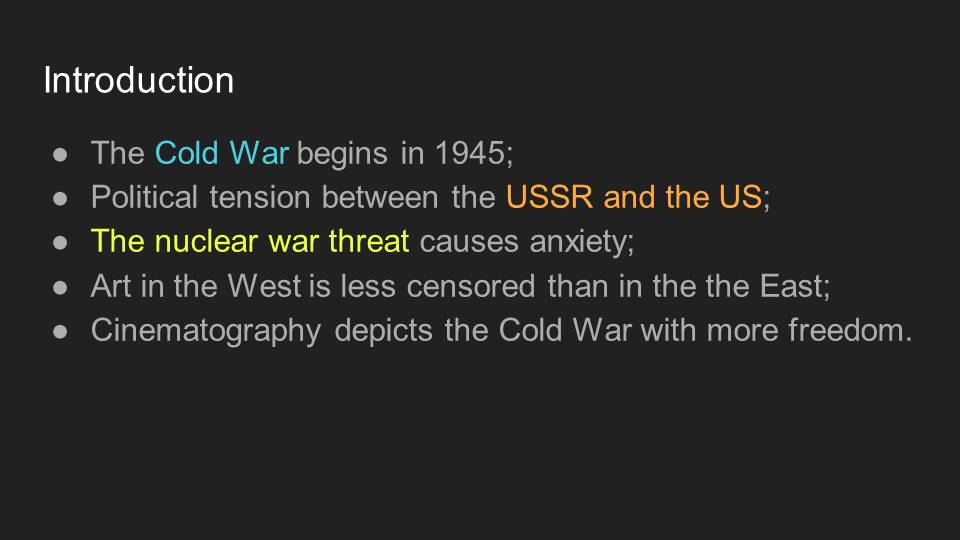
Dr. Strangelove or: How I Learned to Stop Worrying and Love the Bomb. Stanley Kubrick, 1964
Dr. Strangelove or: How I Learned to Stop Worrying and Love the Bomb, often referred to as Dr. Strangelove is a 1964 political satire black comedy written and directed by Stanley Kubrick. Dr. Strangelove reflected the imminent nuclear threat that characterized the Cold War and caused a great deal of tension in American society. The movie starts with the deranged brigadier general Jack D. Ripper who gives in to a conspiracy theory that the Soviets’ are on their way to poison the American people. Eventually, he starts a nuclear World War III by sending bombers to the USSR.
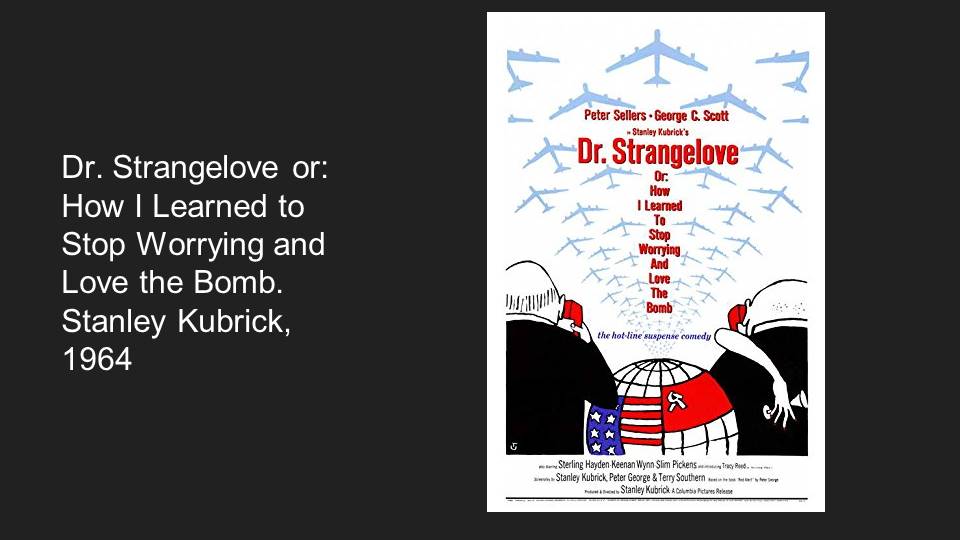
- The bombing of the USSR is in action;
- If it happens, it will trigger the Doomsday Machine;
- Humankind is at risk of being annihilated altogether.
American President Muffley learns about what has just happened and orders to abort the mission. The latter proves to be not quite doable because the general Ripper is the only person who knows the recall code. The operation is in action, unstopped by either the president or his advisors – the second-in-command group captain Lionel Mandrake and a former Nazi doctor Strangelove. In the meantime, the Soviet Premier Kissov announces the launch of the “Doomsday Machine,” an intricate system of underground bombs that spread beyond the Eastern bloc and circle the planet. Kissov explains that any attempt to attack the USSR will result in an automatic detonation, destroying the entire humankind and rendering the Earth uninhabitable.
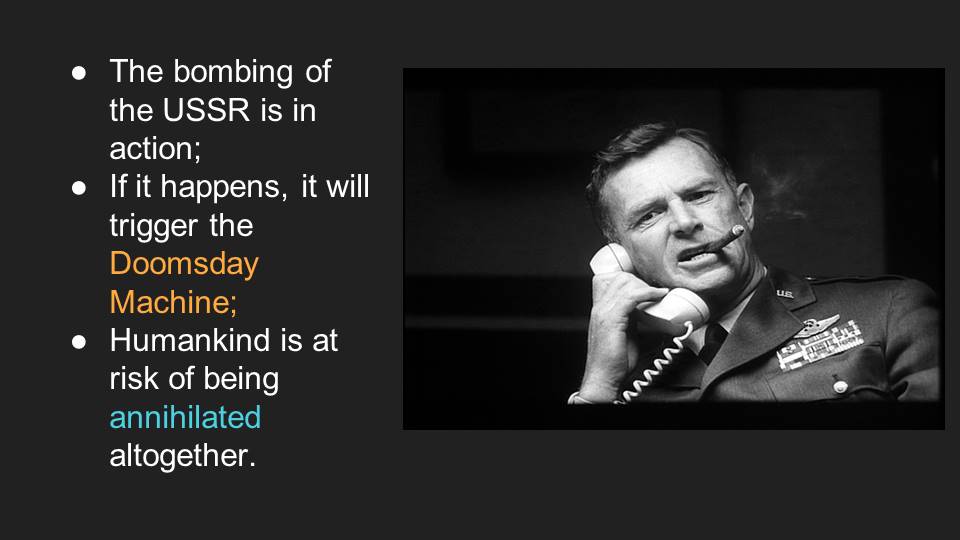
- President recovers the recall code;
- Dr. Strangelove fantasizes about surviving the apocalypse in mineshafts;
- The unaccounted bomber triggers the Doomsday Machine.
After Kissov’s announcement, it becomes clear that if the bombing is successful, it is going to be fatal for the whole planet. President Muffley restores the code from the scribbles left by Ripper, and the mission is aborted. The final two scenes of the movie are where the absurd and satire reach their peak. Dr. Strangelove explains ecstatically the prospects of surviving the nuclear apocalypse while hiding in mineshafts and reproducing with multiple attractive females. His Nazi past resurfaces as he finally combats his disability, stands up straight, and appeals to “Fuhrer.” However, soon it turns out that President’s and advisors’ efforts to avert a catastrophe were futile. An unaccounted bomber triggers the Doomsday Machine, swiping the humanity of the face of the Earth.
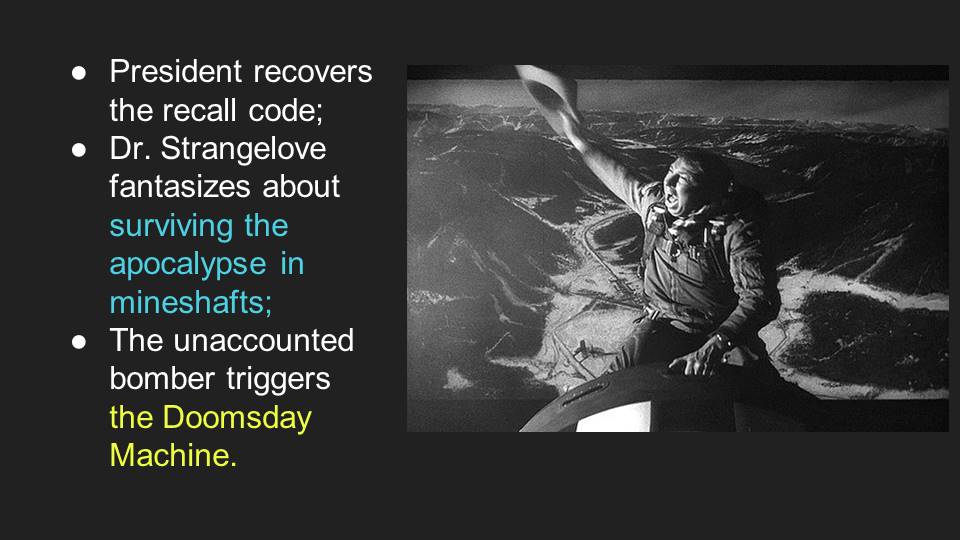
- Dr. Strangelove is a satirical piece that uses grotesque and exaggeration;
- Yet, it can be applied to today’s situation;
- It shows the dangers of the accumulation of power in the hands of one person.
People’s disbelief in the feasibility of “Dr. Strangelove”’s events only proves the importance of such cinematographic masterpieces. At present, the viewer can draw two meaningful conclusions from Kubrick’s movie that are relevant given the current political situation. First and foremost, the character of the deranged brigadier Ripper demonstrates the threats of trusting one person with too much power and leverage. While Ripper indeed single handedly started World War III, it was the faulty system that had allowed him to do so. This idea should especially resonate with the modern viewer due to the actions of the current US president. A few days ago the US House of Representatives attempted to avert another humanitarian catastrophe and voted to limit Trump’s ability to declare war on Iran (“US House of Representatives votes”).

- Dr. Strangelove warns about the threats of rapid technological development;
- It predicted Perimeter – the Soviet system of sensors and computers.
Another conclusion that one may make after watching Dr. Strangelove is the threats of technological development. Probably, the most seemingly bogus and unrealistic element in Kubrick’s movie is the Doomsday Machine. Interestingly enough, as Schlosser writes in his review, the USSR made an attempt to introduce a similar system a decade after the movie came out. The system was called Perimeter: it included computers and sensors allowing junior military officers to launch missiles. Today, Dr. Strangelove may be used to raise awareness of the technological revolution: both its vices and virtues.
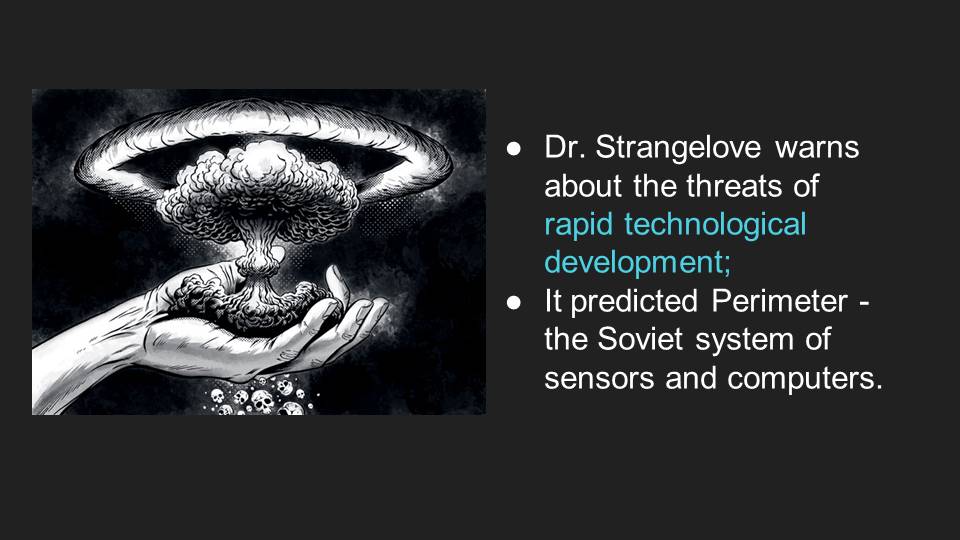
Lumet’s Fail Safe revolved around the same idea as Kubrick’s Dr. Strangelove, the US nuclear attack on the Soviet Union. Schulman writes that Kubrick accused Lumet of plagiarism when he read the synopsis of Fail Safe. The director of Dr. Strangelove only settled the deal when he was reassured that Lumet’s movie would only come out once his comedy had left the theaters. As expected, Fail Safe flopped: after Kubrick’s engaging, absurdist, and brilliant satirical work, the second movie fell flat. Despite its initial failure, decades after its creation, it found critical appraisal. Schulman claims that while Fail Safe might not be as entertaining to watch, given a chance, it can impress the viewer with its maturity.
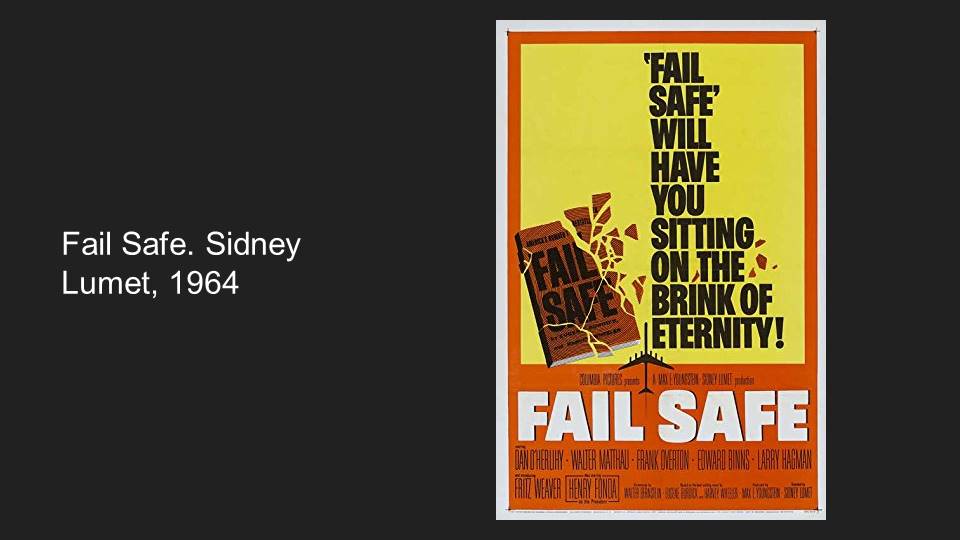
- Lumet provides a more realistic perspective;
- He highlights the price of the human error and faultiness of the system.
As opposed to Dr. Strangelove, it is not a single person who is at fault for bombing the USSR but the missile system, a machine. Lumet depicts the military command trying to stop the attack and two Presidents negotiating through the tension of the Cold War. Unlike Dr. Strangelove, the Presidents in Fail Safe show at least some readiness to exchange technological secrets and avert the great crisis. The situation is aggravated by additional difficulties: the commanders on both sides try to sabotage peaceful negotiations. Aside from that, the advisors want to take radical measures and launch an all-out attack.
At first glance, it seems that Lumet naively blames technology for triggering a conflict. While the concept of threatening, disruptive innovations can be rightfully acknowledged as one of the central ideas of Fail Safe, calling it the end-all be-all of the movie would mean missing its main point. As Schulman points out, the technology itself is indifferent: it is neither good nor bad. Its malfunctioning reflects the faulty system of institutions and procedures and the weight of the human error.

- The Twilight Zone: the Cold War with a human face;
- Sterling shows the struggles of an individual;
- The series depicts the consequences of incivility.
The original Twilight Zone TV series was written and directed by Sterling and aired from 1954 through 1964. Sterling knew that science fiction was a neglected genre that was not taken seriously by TV producers, critics, and censors. While Sterling risked creating an unpopular product, he also knew that a sci-fi series might as well be not as closely scrutinized. The director channeled his vision regarding the Cold War into five episodes of the Twilight Zone with The Shelter being the most resonant and outstanding.
While Sterling embarked on the same topic as Kubrick and Lumet – the nuclear war threat, he approached it from a different standpoint. In Dr. Strangelove and Fail Safe, the viewer sees how the events unfold at the level of the political and military elites. Sterling, on the other hand, humanizes the Cold War: he shows the struggles of an average Joe caused by the tension between the two political powers. In The Shelter, Dr. Stockton tells his neighbors that he has built an underground shelter to keep his family safe. At first, his concerns are not taken seriously and made fun of by his guests. However, as the neighborhood hears the drill announcing a UFO attack, the same neighbors demand that Dr. Stockton let them in. The conflict does not end well as the angry neighbors destroy the shelter, not giving anyone a chance to save themselves. This turn of events makes the episode relatable to Dr. Strangelove and Fail Safe. Just like Kubrick and Lumet, Sterling shows the price of the human error, greed, and incivility.
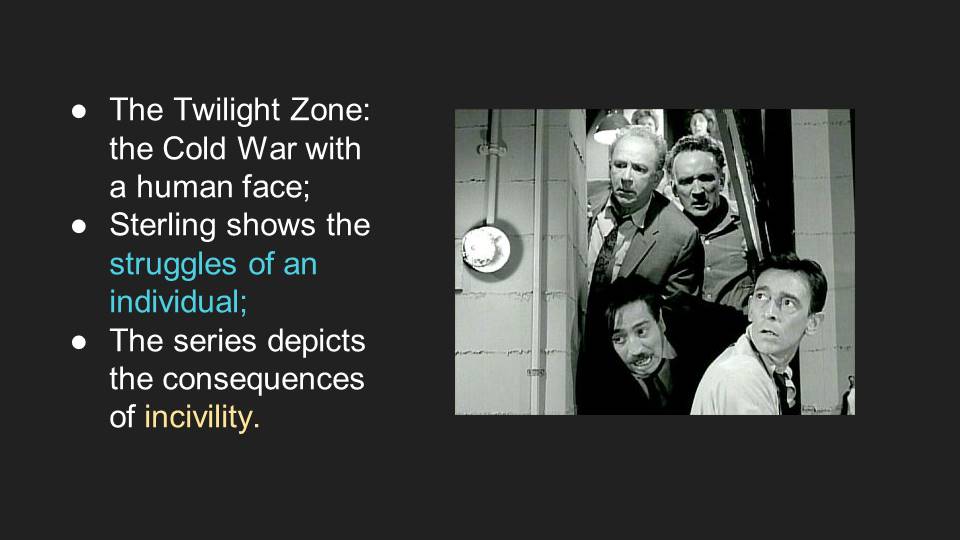
Conclusions
- Anxiety and uncertainty were reflected in cinematography;
- Kubrick shows the consequences of one person’s derangement;
- Lumet teaches about the faults of the human made systems;
- Sterling demonstrates how the Cold War affects an average citizen.
The Cold War was a time when the political tension between the USSR and the US reached the tipping point. The anxious uncertainty surrounding the nuclear war threat was translated into several artistic masterpieces. In 1964, Kubrick created Dr. Strangelove in which he showed the consequences of a single person’s derangement and paranoia for the entire planet. As opposed to Kubrick’s satire, Lumet took a more realistic, melodramatic approach. Fail Safe teaches the viewer about the faultiness of a system that mishandles technology and puts humanity at risk of being annihilated. In The Twilight Zone, Sterling draws on the same ideas but also humanizes the issue and demonstrates how the Cold War affects an average citizen.

Works Cited
Dr. Strangelove or: How I Learned to Stop Worrying and Love the Bomb. Directed by Stanley Kubrick, performance by Peter Sellers. Hawk Films, 1964.
Fail Safe. Directed by Sidney Lumet, performance by Henry Fonda. Columbia Pictures, 1964.
Schlosser, Eric. Almost Everything in Dr. Strangelove Was True. Web.
Schulman, Ari N. Doomsday Machines. Web.
The Twilight Zone. Directed by Rod Serling, performance by Theodore Bikel. Cayuga Productions, Inc., 1959-1964.
US House of Representatives votes to limit Trump’s ability to declare war on Iran. 2020.